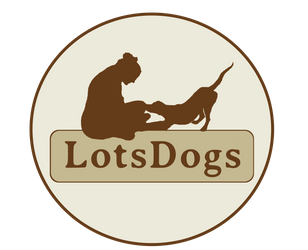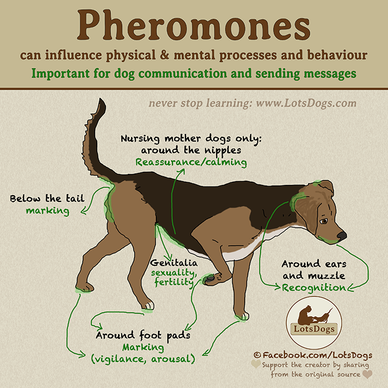Pheromones
Pheromones are fascinating molecules. Although humans are not consciously aware of their presence, these chemical signals can influence behaviour.
Pheromones can not only activate physical, mental and behavioural responses, they can also signal messages to members of the same species. Messages of which we humans are not aware and we are still trying to find out their meaning.
More research needs to be done, but in this article I would like to share my latest findings about dog pheromones and their influence on dog behaviour.
Dog pheromone detection
Dogs can gather information about their environment through their eyes (sight), nose (olfactory system), their mouth (taste buds), touch (tactile) and through a specialized sensory organ in their muzzle (top jaw, above the soft palate in the mouth) called the vomeronasal organ (VNO). The VNO can detect and respond to pheromones.
Sometimes, if you look closely, you can see dogs using their VNO when they open and close their mouth slightly while sniffing the air.
Dog pheromone communication
More research needs to be done, but dog pheromones seem to be secreted from different parts of the dog body and they each seem to communicate different types of messages.
- From behind the ears and around the muzzle
These pheromones seem to play a rol in recognition and reassurance in relation to social bonds.
Think about this when you see dogs greeting and they sniff around the neck, ears and muzzle of one another.
- Around the foot pads, underneath their feet
These pheromones seem to play a role in marking (perhaps to leave a message, either for other dogs to find, or for themselves when they revisit the location). When you see dogs scratching the ground, they are probably leaving important messages, so let your dog do this. It might be related to a form of arousal (perhaps vigilance).
- Around the anal sacs, underneath the tail of the dog
These pheromones have a prominent role in marking and leaving messages for other dogs and themselves. They are released during pooping and peeing, but may also be released when a dog raises and/or wags the tail.
- Around the genitals
These pheromones communicate information about the dogs sex and fertility and these are also released during peeing, but may also be released during sexual arousal or when females are in heat.
- Only for mother dogs: around the nipples when a mother dog (dam) has puppies that she is taking care of.
These pheromones seem to calm and reassure puppies, especially when the dam leaves the nest to gather food, those pheromones seem to keep the puppies calm while they wait in the nest.
Pheromonal therapy
Because pheromones can influence dog behaviour, humans have been researching and experimenting to see if pheromones can be recreated chemically and then used in behavioural therapy. An example is the Dog Appeasing Pheromone, which is a chemical replica of the pheromone that a mother dog can release for reassuring her puppies. Because of the reassuring/calming effect, DAP can be used to support dogs that are being treated for fear, anxiety or panic issues (in example, separation related problems).
Research is suggesting that this can have a positive effect on therapy. However, behavioural therapy is also strongly influenced by associations (experience and learning). In example, a dog who was separated from the mother very early, or a dog that does not have pleasant associations with the mother or the puppy nest, may not respond to those pheromones.
In addition, very strong negative associations are not changed by adding the pheromone, so if a dog, in example, has a very negative association with being inside of a car, adding the pheromone, will probably not change the association. However, when introducing a new object or environment, adding the pheromone may help. This will differ per dog and per situation.
Pheromones are important to dogs
Though more research needs to be done, it is good to be aware of the importance of pheromones to dogs and their influence on behaviour. Knowing about pheromones, could help you understand why a dog could suddenly change his/her behaviour or posture on walks, even though you can’t see anything. Dogs can sense and gather a lot more information from their environment than we humans can. It may also explain why dogs feel the need to sniff other dogs, checking their pheromones and messages.
If your dog feels the need to mark or scratch the surface, please note that this may be of great importance for leaving messages, not only for other dogs, but for themselves to come back to.
This emphasizes the importance of letting your dog sniff and gather information about the environment. Being able to gather information about the environment is a welfare need for dogs.
© LotsDogs | Written by Liselot Boersma, welfare consultant (PgDip CABW) and owner of LotsDogs, August 2018 and translated in May 2020. Copy paste of images or text is forbidden. Sharing the URL of this website is very much appreciated. Many thanks in advance.
Resources/further reading:



